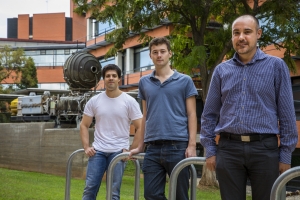IFIC researchers solve the problem of the dimensions of space-time of the theories that apply to the LHC
The theories used to predict the behavior of the data from the Large Hadron Collider (LHC) at CERN, which have led among other results to the discovery of the Higgs boson, are poorly defined in the four dimensions of space-time that Einstein established. To avoid the appearance of infinities in calculations in these theories new dimensions were introduced in a 'mathematical trick' which, however, does not correspond to what we know at the moment of our Universe. Now, a group of researchers from the Institute of Corpuscular Physics (IFIC, CSIC-UV) has developed a method that avoids the appearance of those infinities and keeps the theory in the usual four dimensions of space-time.
The origin of the problem is that, from the theoretical point of view, particles in the LHC collisions could be produced with zero energy, which also is different from not emitting any particle. The same occurs when two particles are produced exactly in the same direction: they are indistinguishable from a single particle. Another problem stems from the need to introduce quantum corrections in the theoretical calculations, requiring to extrapolate the validity of these theories to infinite energies ever achieved in a particle accelerator.
However, from the viewpoint of the experiment, these situations are hardly acceptable. For the theory, assuming them has a price: the appearance of infinities in the four dimensions of space-time, continuous linking the two concepts that set Einstein's Special Relativity. And the infinities in turn are incompatible with theoretical predictions.
The solution found in 1972 Nobel Prize winners Gerardus' t Hooft and Martinus J. G.'t Veltman was to alter the dimensions of space-time. The method, known as Dimensional Regularization defines the theory in a space-time of more than four dimensions. Infinities arising in four dimensions then appear as contributions that depend on the dimensional difference with respect to four. It is a 'mathematical trick' to model these infinities in intermediate steps of calculations for obtaining predictions impossible to obtain otherwise.
However, a group of researchers from the Institute of Corpuscular Physics led by Germán Rodrigo has developed a new method that redefines the theory avoiding the appearance of infinities, and allows therefore to maintain the theory in the usual four dimensions of space-time. The method involves a change in how theoretical predictions of high precision with which to compare the LHC experimental data are obtained, it simplifies the complex calculations that have to be made, and solves one of the main problems that particle physicists have to face when translating the theory to experiment.
The method is based on a direct correspondence established between different Feynman diagrams leading to the appearance of infinities. These diagrams, proposed by Richard P. Feynman Nobel Prize in 1965, are used by physicists to represent pictorially the collisions produced at very high energies between subatomic particles at large accelerators like the LHC. The correspondence relationship, developed by IFIC´s researchers in collaboration with the group of the University of Florence directed by Stefano Catani under the name of 'loop-tree duality', unifies quantum states that are different for the theory but are not from the experimental point of view, as a particle having zero energy or events with no emission of extra particles.
The new algorithm was presented by IFIC researcher Germán Sborlini in the world's leading particle physics conference, ICHEP 2016, held in early August in Chicago. In addition, it has been recently published in Journal of High Energy Physics.
More information:
“Four-dimensional unsubtraction from the loop-tree duality”, G.F.R. Sborlini, F. Driencourt-Mangin, R. Hernández-Pinto and G. Rodrigo. J. High Energ. Phys. (2016) 2016: 160. doi:10.1007/JHEP08(2016)160




















